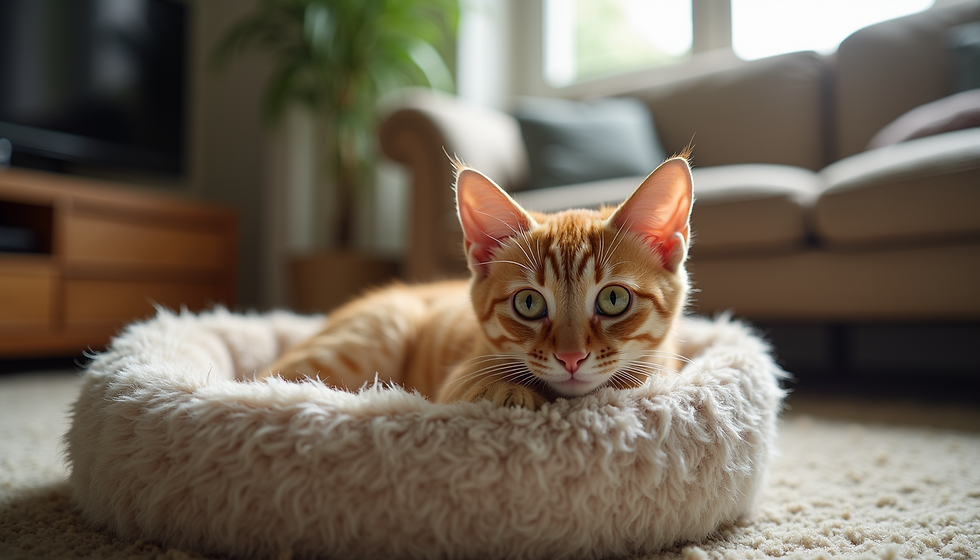Decoding Feline Communication: A Comprehensive Guide to Understanding Your Cat's Behavior
- Aug 6
- 3 min read
Understanding cat behavior can be a rewarding journey, offering insights into your feline companion's needs and emotions. Cats communicate in unique ways, often relying on body language, vocalizations, and various behaviors to express their feelings. By decoding these signals, you can create a harmonious living environment that caters to your cat's requirements, ensuring a stronger bond between you and your pet.
The Importance of Understanding Cat Behavior
Recognizing and interpreting your cat's behavior is crucial for their well-being. Cats cannot vocalize their needs and desires clearly, so they often resort to non-verbal cues. By understanding cats and their communication style, you’ll be better equipped to respond to their needs and emotions efficiently.
Understanding your cat's behavior also allows you to identify any potential health issues early on. Changes in behavior can be a sign of physical discomfort or psychological distress. Thus, being attentive to your cat's actions and reactions will not only enhance your relationship but may also contribute to a longer, healthier life for your furry friend.
Common Cat Behaviors and Their Meanings
Purring
Purring is one of the most recognizable forms of cat communication. While commonly associated with contentment, cats may also purr when they are in pain or anxious. If your cat is purring while curled up on your lap, it’s likely a sign of happiness. However, if your cat is purring during a stressful situation (like a visit to the vet), they might be using it as a self-soothing mechanism.
Kneading
Have you ever noticed your cat kneading with their paws? This behavior, often referred to as "making biscuits," can be a sign of comfort and security. Cats often knead when they are feeling happy or relaxed, reminiscent of when they were kittens nursing from their mothers. If your cat kneads on your lap, it signifies affection and trust.
Tail Position
A cat’s tail is a robust indicator of their mood. A tail held high signifies confidence and happiness, while a low or tucked tail can indicate fear or submission. If your cat’s tail is puffed up, they may be startled or feeling threatened. Understanding tail positions can help you gauge your cat's emotional state and respond accordingly.
Slow Blinking
The "slow blink" is often referred to as a cat's way of saying, "I trust you." When your cat looks at you and slowly closes their eyes, it's a sign of affection. You can reciprocate this behavior by slowly blinking back at your cat, fostering trust and strengthening your bond.
Scratching
Cats have a natural instinct to scratch, which helps them keep their claws sharp and shed old material. However, when scratching becomes destructive, it indicates that your cat needs a designated scratching post or surface. Providing suitable options can help redirect this behavior and save your furniture!
Covert Hunting Behavior
Cats are natural hunters, and their play often mimics hunting behavior. If your cat pounces on toys or stalks you as you walk by, this action is part of their instinctual behavior. Engaging in playtime with your cat using interactive toys can fulfill their predatory instincts, mitigating potential behavioral issues that arise from pent-up energy.
Responding to Your Cat's Needs
Understanding cat communication is vital, but knowing how to respond is equally important. Here are some actionable tips to ensure your cat feels safe and loved in your home.
Establish a Routine
Cats thrive on routine and predictability. Feed your cat at the same times each day and provide regular playtime. Establishing a routine can create a sense of security for them, reducing anxiety.
Create a Safe Space
Every cat needs a place where they can retreat when feeling overwhelmed. Set up cozy spots with beds or blankets and ensure this place is away from noise or commotion. This sanctuary can help your cat feel secure and protected.
Play and Enrichment
Cats require stimulation to stay healthy and happy. Provide a range of toys and even puzzle feeders to keep their minds engaged. Regular interactive playtime is essential for their physical well-being and helps strengthen your bond.
Be Patient
Decoding cat behavior takes time and patience. Each cat is unique, with their own personality and quirks. By observing and responding to their needs, you can develop a deeper understanding of their communication style, leading to a more fulfilling relationship.
Conclusion
Understanding cat behavior is an essential part of pet ownership that enhances the bond between you and your feline companion. By learning to decode their signals, you can better cater to their emotional and physical needs. This knowledge not only improves your cat's quality of life but can also lead to a more harmonious household.
Remember, your cat's behavior is a language they use to communicate with you. Take the time to observe closely, respond thoughtfully, and enjoy the loving companionship that your understanding can foster. Embrace the journey of feline communication, and you'll find that your cat's trust and affection will grow in leaps and bounds.







Comments